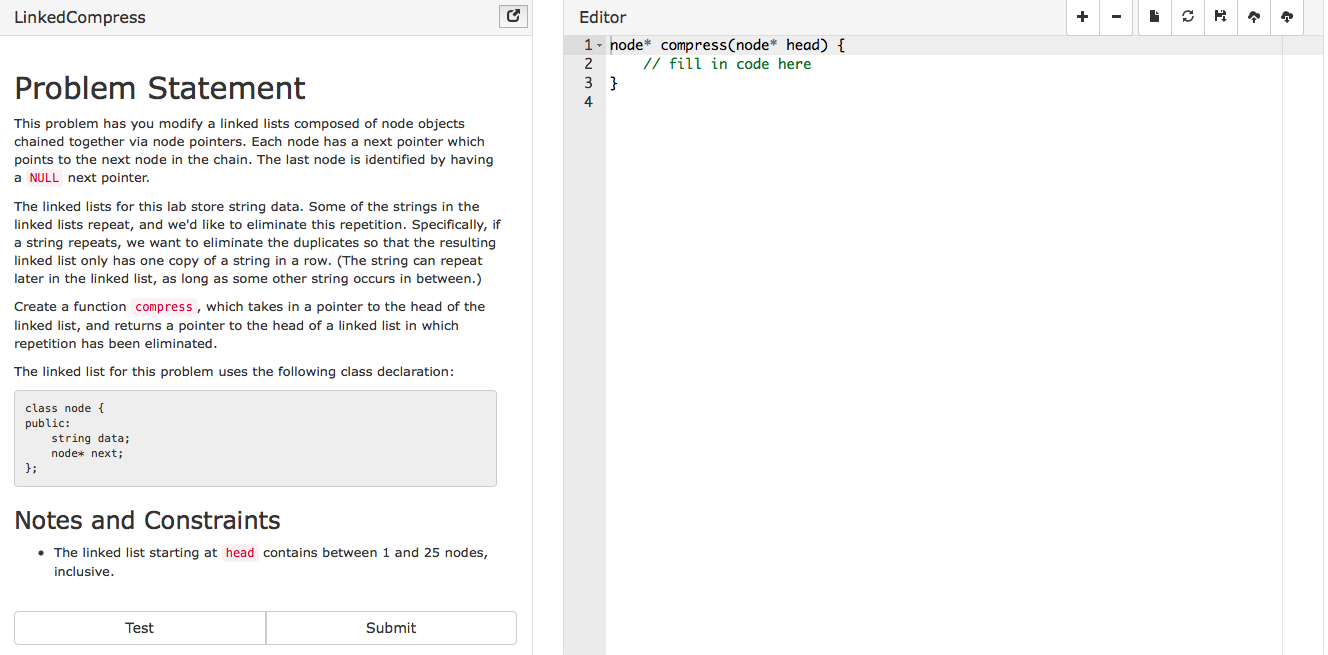LinkedCompress Editor 1 node compressCnode* head) //fill in code here Problem Statement 4 This problem has you modify a linked lists composed of node objects chained together via node pointers. Each node has a next pointer which points to the next node in the chain. The last node is identified by having a NULL next pointer. The linked lists for this lab store string data. Some of the strings in the linked lists repeat, and we'd like to eliminate this repetition. Specifically, if a string repeats, we want to eliminate the duplicates so that the resulting linked list only has one copy of a string in a row. (The string can repeat later in the linked list, as long as some other string occurs in between.) Create a function compress, which takes in a pointer to the head of the linked list, and returns a pointer to the head of a linked list in which repetition has been eliminated The linked list for this problem uses the following class declaration class node public: string data; node* next; d: Notes and Constraints The linked list starting at head contains between 1 and 25 nodes, inclusive Test Submit
LinkedCompress Editor 1 node compressCnode* head) //fill in code here Problem Statement 4 This problem has you modify a linked lists composed of node objects chained together via node pointers. Each node has a next pointer which points to the next node in the chain. The last node is identified by having a NULL next pointer. The linked lists for this lab store string data. Some of the strings in the linked lists repeat, and we'd like to eliminate this repetition. Specifically, if a string repeats, we want to eliminate the duplicates so that the resulting linked list only has one copy of a string in a row. (The string can repeat later in the linked list, as long as some other string occurs in between.) Create a function compress, which takes in a pointer to the head of the linked list, and returns a pointer to the head of a linked list in which repetition has been eliminated The linked list for this problem uses the following class declaration class node public: string data; node* next; d: Notes and Constraints The linked list starting at head contains between 1 and 25 nodes, inclusive Test Submit
C++ Programming: From Problem Analysis to Program Design
8th Edition
ISBN:9781337102087
Author:D. S. Malik
Publisher:D. S. Malik
Chapter17: Linked Lists
Section: Chapter Questions
Problem 18SA
Related questions
Question
C++ Thanks!
Example:
"apple"->NULL
return "apple"->NULL
"apple"->"apple"->NULL
return "apple"->NULL
"green"->"green"->"blue"->"red"->"green"->NULL
return "green"->"blue"->"red"->"green"->NULL

Transcribed Image Text:LinkedCompress
Editor
1 node compressCnode* head)
//fill in code here
Problem Statement
4
This problem has you modify a linked lists composed of node objects
chained together via node pointers. Each node has a next pointer which
points to the next node in the chain. The last node is identified by having
a NULL next pointer.
The linked lists for this lab store string data. Some of the strings in the
linked lists repeat, and we'd like to eliminate this repetition. Specifically, if
a string repeats, we want to eliminate the duplicates so that the resulting
linked list only has one copy of a string in a row. (The string can repeat
later in the linked list, as long as some other string occurs in between.)
Create a function compress, which takes in a pointer to the head of the
linked list, and returns a pointer to the head of a linked list in which
repetition has been eliminated
The linked list for this problem uses the following class declaration
class node
public:
string data;
node* next;
d:
Notes and Constraints
The linked list starting at head contains between 1 and 25 nodes,
inclusive
Test
Submit
Expert Solution
This question has been solved!
Explore an expertly crafted, step-by-step solution for a thorough understanding of key concepts.
This is a popular solution!
Trending now
This is a popular solution!
Step by step
Solved in 5 steps with 1 images

Knowledge Booster
Learn more about
Need a deep-dive on the concept behind this application? Look no further. Learn more about this topic, computer-science and related others by exploring similar questions and additional content below.Recommended textbooks for you

C++ Programming: From Problem Analysis to Program…
Computer Science
ISBN:
9781337102087
Author:
D. S. Malik
Publisher:
Cengage Learning

C++ Programming: From Problem Analysis to Program…
Computer Science
ISBN:
9781337102087
Author:
D. S. Malik
Publisher:
Cengage Learning